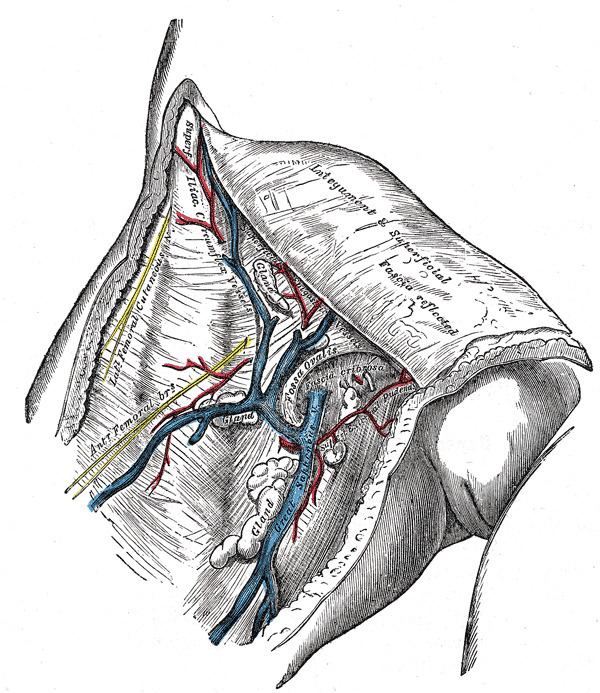MeSH A07.231.908.819 TA A12.3.11.003 | Latin vena saphena magna Dorlands/Elsevier v_05/12851675 | |
 | ||
Source dorsal venous arch of the foot, and others | ||
The great saphenous vein (GSV), previously also called the long saphenous vein, is a large, subcutaneous, superficial vein of the leg. It is the longest vein in the body running along the length of the lower limb.
Contents
- Structure
- Tributaries
- Clinical significance
- Use in cardiovascular procedures
- Use in emergency medicine
- References
The terms "saphaina" (Greek, meaning "manifest," "to be clearly seen") and "safoon" (Hebrew, "שָׂפוּן" meaning "hidden/covered") as well as "safin" (Arabic, "صَافِن" meaning "deep/embedded") have been claimed as the origin for the word "saphenous."
Structure
The great saphenous vein originates from where the dorsal vein of the big toe (the Hallux) merges with the dorsal venous arch of the foot. After passing in front of the medial malleolus (where it often can be visualized and palpated), it runs up the medial side of the leg. At the knee, it runs over the posterior border of the medial epicondyle of the femur bone. The GSV then courses anteriorly to lie on the anterior surface of the thigh before entering an opening in the fascia lata called the saphenous opening. It forms an arch, the saphenous arch, to join the common femoral vein in the region of the femoral triangle at the sapheno-femoral junction.
Tributaries
At the ankle it receives branches from the sole of the foot through the medial marginal vein; in the lower leg it anastomoses freely with the small saphenous vein, communicates by perforator veins (Cockett perforators) with the anterior and posterior tibial veins and receives many cutaneous veins; near the knee it communicates with the popliteal vein by the Boyd perforator, in the thigh it communicates with the femoral vein by perforator veins (Dodd perforator) and receives numerous tributaries; those from the medial and posterior parts of the thigh frequently unite to form a large accessory saphenous vein which joins the main vein near the sapheno-femoral junction.
Near the fossa ovalis it is joined by the superficial epigastric, superficial circumflex iliac vein, and superficial external pudendal veins.
The thoracoepigastric vein runs along the lateral aspect of the trunk between the superficial epigastric vein below and the lateral thoracic vein above and establishes an important communication between the femoral vein and the axillary vein.
Clinical significance
Pathology of the great saphenous vein is relatively common, but in isolation typically not life-threatening.
Use in cardiovascular procedures
The vein is often removed by cardiac surgeons and used for autotransplantation in coronary artery bypass operations, when arterial grafts are not available or many grafts are required, such as in a triple bypass or quadruple bypass.
The great saphenous vein is the conduit of choice for vascular surgeons, when available, for doing peripheral arterial bypass operations [ see vascular bypass ] because it has superior long-term patency compared to synthetic grafts (PTFE, PETE (Dacron)), human umbilical vein grafts or biosynthetic grafts [Omniflow]. Often, it is used in situ (in place), after tying off smaller tributaries and destruction of the venous valves with a device called valvulotome, e.g. LeMaitre's valvulotome.
Removal of the saphenous vein will not hinder normal circulation in the leg. The blood that previously flowed through the saphenous vein will change its course of travel. This is known as collateral circulation.
The saphenous nerve is a branch of the femoral nerve that runs with the great saphenous vein and can be damaged in surgery on the vein.
Use in emergency medicine
When emergency resuscitation with fluids is necessary, and standard intravenous access cannot be achieved due to venous collapse, saphenous vein cutdown may be necessary.
